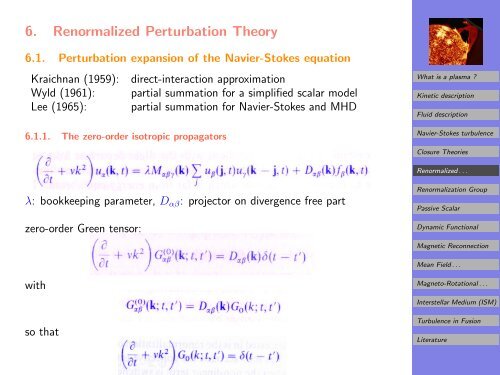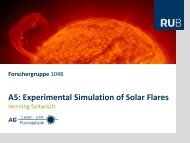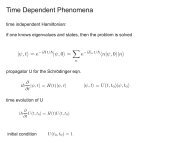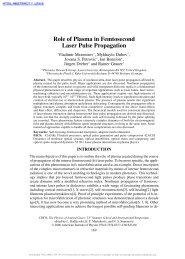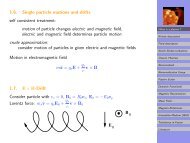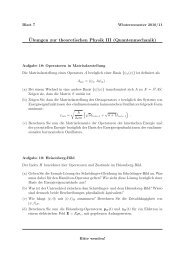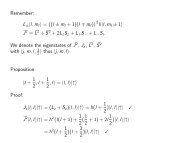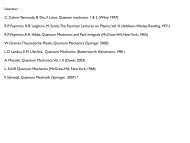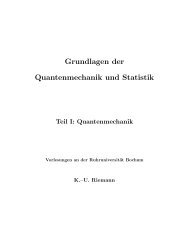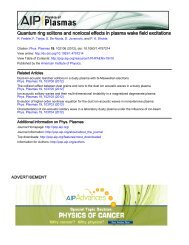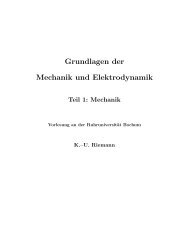6. Renormalized Perturbation Theory
6. Renormalized Perturbation Theory
6. Renormalized Perturbation Theory
You also want an ePaper? Increase the reach of your titles
YUMPU automatically turns print PDFs into web optimized ePapers that Google loves.
<strong>6.</strong> <strong>Renormalized</strong> <strong>Perturbation</strong> <strong>Theory</strong><br />
<strong>6.</strong>1. <strong>Perturbation</strong> expansion of the Navier-Stokes equation<br />
Kraichnan (1959): direct-interaction approximation<br />
Wyld (1961): partial summation for a simplified scalar model<br />
Lee (1965): partial summation for Navier-Stokes and MHD<br />
<strong>6.</strong>1.1. The zero-order isotropic propagators<br />
What is a plasma ?<br />
Kinetic description<br />
Fluid description<br />
Navier-Stokes turbulence<br />
Closure Theories<br />
<strong>Renormalized</strong> . . .<br />
λ: bookkeeping parameter, D αβ : projector on divergence free part<br />
zero-order Green tensor:<br />
Renormalization Group<br />
Passive Scalar<br />
Dynamic Functional<br />
Magnetic Reconnection<br />
Mean Field . . .<br />
with<br />
Magneto-Rotational . . .<br />
Interstellar Medium (ISM)<br />
so that<br />
Turbulence in Fusion<br />
Literature
zero-order velocity:<br />
What is a plasma ?<br />
Kinetic description<br />
Fluid description<br />
Fourier transform in time:<br />
Navier-Stokes turbulence<br />
Closure Theories<br />
<strong>Renormalized</strong> . . .<br />
=⇒ Navier-Stokes<br />
Renormalization Group<br />
Passive Scalar<br />
Dynamic Functional<br />
Magnetic Reconnection<br />
zero-order propagator is given by<br />
Mean Field . . .<br />
Magneto-Rotational . . .<br />
Interstellar Medium (ISM)<br />
Turbulence in Fusion<br />
Literature
<strong>6.</strong>1.2. The primitive perturbation expansion<br />
Stirring force<br />
What is a plasma ?<br />
after Fourier-trafo<br />
Kinetic description<br />
Fluid description<br />
Navier-Stokes turbulence<br />
zero-order velocity field after in Fourier-space<br />
Closure Theories<br />
<strong>Renormalized</strong> . . .<br />
which is the zero-order term in expansion<br />
Renormalization Group<br />
Passive Scalar<br />
Dynamic Functional<br />
correlation Q αβ (k; ω, ω ′ )<br />
Magnetic Reconnection<br />
Mean Field . . .<br />
Magneto-Rotational . . .<br />
Interstellar Medium (ISM)<br />
Turbulence in Fusion<br />
Literature
homogeneous isotropic turbulence<br />
and<br />
<strong>Perturbation</strong> expansion for Q<br />
What is a plasma ?<br />
Kinetic description<br />
Fluid description<br />
Navier-Stokes turbulence<br />
Closure Theories<br />
<strong>Renormalized</strong> . . .<br />
Renormalization Group<br />
Passive Scalar<br />
Dynamic Functional<br />
Magnetic Reconnection<br />
Mean Field . . .<br />
Take Fourier transformed NS-equation, invert linear part and substitute<br />
forcing by u (0)<br />
Magneto-Rotational . . .<br />
Interstellar Medium (ISM)<br />
Turbulence in Fusion<br />
Literature
Now substitute perturbation expansion for u<br />
What is a plasma ?<br />
Kinetic description<br />
Fluid description<br />
Navier-Stokes turbulence<br />
Closure Theories<br />
<strong>Renormalized</strong> . . .<br />
equating coefficients:<br />
Renormalization Group<br />
Passive Scalar<br />
Dynamic Functional<br />
Magnetic Reconnection<br />
Mean Field . . .<br />
u (2) can be expressed by u (0)<br />
Magneto-Rotational . . .<br />
Interstellar Medium (ISM)<br />
Turbulence in Fusion<br />
Literature
stirring Gaussian =⇒ u (0) Gaussian<br />
=⇒ 〈 u (0) u (0) u (0) u (0)〉 can be factored as in Quasi-Normal approximation<br />
second-order correlation tensor:<br />
What is a plasma ?<br />
Kinetic description<br />
Fluid description<br />
Navier-Stokes turbulence<br />
Closure Theories<br />
<strong>Renormalized</strong> . . .<br />
Renormalization Group<br />
Passive Scalar<br />
Dynamic Functional<br />
Magnetic Reconnection<br />
Mean Field . . .<br />
Magneto-Rotational . . .<br />
Interstellar Medium (ISM)<br />
Turbulence in Fusion<br />
Literature
<strong>6.</strong>1.3. Graphical representation of the perturbation series<br />
all orders can be expressed by zero-order terms, but divergent series<br />
three main constituents: u (0) , G 0 and M<br />
What is a plasma ?<br />
Kinetic description<br />
Fluid description<br />
Navier-Stokes turbulence<br />
Closure Theories<br />
zero-order:<br />
<strong>Renormalized</strong> . . .<br />
Renormalization Group<br />
Passive Scalar<br />
first-order: wavenumber conservation<br />
Dynamic Functional<br />
Magnetic Reconnection<br />
Mean Field . . .<br />
Magneto-Rotational . . .<br />
Interstellar Medium (ISM)<br />
Turbulence in Fusion<br />
Literature
second-order: two M factors:<br />
What is a plasma ?<br />
Kinetic description<br />
Fluid description<br />
Navier-Stokes turbulence<br />
Closure Theories<br />
<strong>Renormalized</strong> . . .<br />
Renormalization Group<br />
third-order: three M factors:<br />
Passive Scalar<br />
Dynamic Functional<br />
Magnetic Reconnection<br />
Mean Field . . .<br />
Magneto-Rotational . . .<br />
Interstellar Medium (ISM)<br />
Turbulence in Fusion<br />
Literature
graphical expansion for correlation tensor<br />
zero-order:<br />
What is a plasma ?<br />
Kinetic description<br />
second-order:<br />
Fluid description<br />
Navier-Stokes turbulence<br />
Closure Theories<br />
<strong>Renormalized</strong> . . .<br />
Renormalization Group<br />
Passive Scalar<br />
Dynamic Functional<br />
Magnetic Reconnection<br />
this is middle second-order term:<br />
Mean Field . . .<br />
Magneto-Rotational . . .<br />
Interstellar Medium (ISM)<br />
Turbulence in Fusion<br />
Literature
What is a plasma ?<br />
Kinetic description<br />
Fluid description<br />
this is the last second-order term:<br />
Navier-Stokes turbulence<br />
Closure Theories<br />
<strong>Renormalized</strong> . . .<br />
Renormalization Group<br />
Passive Scalar<br />
Dynamic Functional<br />
Magnetic Reconnection<br />
Mean Field . . .<br />
The third is a mirrow image of this one.<br />
Magneto-Rotational . . .<br />
Interstellar Medium (ISM)<br />
Turbulence in Fusion<br />
Literature
fourth-order showing four of the 29 fourth-order diagrams:<br />
What is a plasma ?<br />
Kinetic description<br />
Fluid description<br />
Navier-Stokes turbulence<br />
Closure Theories<br />
<strong>Renormalized</strong> . . .<br />
Renormalization Group<br />
Now resummation (renormalisation): new diagram elements<br />
Passive Scalar<br />
Dynamic Functional<br />
Magnetic Reconnection<br />
Mean Field . . .<br />
Magneto-Rotational . . .<br />
Write correlation tensor as:<br />
Interstellar Medium (ISM)<br />
Turbulence in Fusion<br />
Literature
<strong>6.</strong>1.4. Class A diagram: the renormalized propagator<br />
Wyld (1961):<br />
Class A diagrams are those diagrams which can be split into<br />
two pieces by cutting a single Q 0 line.<br />
zero-order: Q 0 can be expressed in terms of two zero-order propagators<br />
acting on the spectrum of the stirring forces w(k; ω, ω ′ )<br />
This looks graphically like<br />
What is a plasma ?<br />
Kinetic description<br />
Fluid description<br />
Navier-Stokes turbulence<br />
Closure Theories<br />
<strong>Renormalized</strong> . . .<br />
Now second-order:<br />
Renormalization Group<br />
Passive Scalar<br />
Dynamic Functional<br />
Magnetic Reconnection<br />
Mean Field . . .<br />
Magneto-Rotational . . .<br />
Let’s summarize: at zero order, we have w with a G 0 on each side. At<br />
second order, w has a G 0 on one side and a diagram which connects like a<br />
G 0 on the other. This holds for all orders. Thus we have a generalization<br />
Interstellar Medium (ISM)<br />
Turbulence in Fusion<br />
Literature
of<br />
which reads<br />
where G(k, ω) is the renormalized propagator.<br />
Graphically, this corresponds to<br />
What is a plasma ?<br />
Kinetic description<br />
Fluid description<br />
Navier-Stokes turbulence<br />
Closure Theories<br />
<strong>Renormalized</strong> . . .<br />
Renormalization Group<br />
Passive Scalar<br />
Dynamic Functional<br />
Magnetic Reconnection<br />
Mean Field . . .<br />
Magneto-Rotational . . .<br />
Interstellar Medium (ISM)<br />
Turbulence in Fusion<br />
Literature
<strong>6.</strong>1.5. Class B diagrams: renormalized perturbation series<br />
Class B diagrams can’t be split into two by cutting a single Q 0 line.<br />
In the class A diagrams, certain diagram parts were propagator like, that is,<br />
they connected like G 0 : renormalize G 0 by adding up all diagrams which<br />
connect like G 0 .<br />
Renormalize vertex: add up all diagrams which connect like a vertex<br />
Example: consider fourth-order diagram<br />
What is a plasma ?<br />
Kinetic description<br />
Fluid description<br />
Navier-Stokes turbulence<br />
Closure Theories<br />
<strong>Renormalized</strong> . . .<br />
Renormalization Group<br />
Passive Scalar<br />
The part<br />
Dynamic Functional<br />
Magnetic Reconnection<br />
Mean Field . . .<br />
Magneto-Rotational . . .<br />
connects like a point vertex =⇒ renormalized vertex<br />
Interstellar Medium (ISM)<br />
Turbulence in Fusion<br />
Literature
eplace vertex by renormalized vertex:<br />
What is a plasma ?<br />
Kinetic description<br />
Fluid description<br />
Navier-Stokes turbulence<br />
Closure Theories<br />
Therefore the key to the class B diagrams is as follows:<br />
1. Find those diagrams which cannot be reduced to a lower order by<br />
replacing diagram parts.<br />
2. Call these the irreducible diagrams.<br />
3. Replace all elements in the irreducible diagrams by their renormalized<br />
forms.<br />
4. Write down all these modified diagrams in order, thus generating a<br />
renormalized perturbation expansion.<br />
<strong>Renormalized</strong> . . .<br />
Renormalization Group<br />
Passive Scalar<br />
Dynamic Functional<br />
Magnetic Reconnection<br />
Mean Field . . .<br />
Magneto-Rotational . . .<br />
Interstellar Medium (ISM)<br />
Turbulence in Fusion<br />
Literature
Result for Q(k; ω, ω ′ )<br />
What is a plasma ?<br />
Kinetic description<br />
Fluid description<br />
Navier-Stokes turbulence<br />
Closure Theories<br />
<strong>Renormalized</strong> . . .<br />
Renormalization Group<br />
This is an integral equation for Q(k; ω, ω)<br />
Passive Scalar<br />
Dynamic Functional<br />
Combine vertex and propagator expansions:<br />
Integral equation for the renormalized vertex<br />
Magnetic Reconnection<br />
Mean Field . . .<br />
Magneto-Rotational . . .<br />
Interstellar Medium (ISM)<br />
Turbulence in Fusion<br />
Literature
Integral equation for the renormalized propagator G(k, ω)<br />
What is a plasma ?<br />
Kinetic description<br />
Fluid description<br />
Navier-Stokes turbulence<br />
Closure Theories<br />
<strong>Renormalized</strong> . . .<br />
Pecularity of this diagram:<br />
unrenormalized propagator emerging from the left !!!<br />
Reason for this: symbolic form of Navier-Stokes<br />
L 0 u(k) = λM(k)u(j)u(k − j) , L 0 = ∂ t + νk 2<br />
and renormalize r.h.s., then invert L 0 which results in G 0<br />
Renormalization Group<br />
Passive Scalar<br />
Dynamic Functional<br />
Magnetic Reconnection<br />
Mean Field . . .<br />
Magneto-Rotational . . .<br />
Interstellar Medium (ISM)<br />
Turbulence in Fusion<br />
Literature
<strong>6.</strong>1.<strong>6.</strong> Second-order closures<br />
What have we done:<br />
We replaced a wildly divergent series with one of unknown properties !<br />
We have hope that it might be assymptotic, but we simple don’t know !<br />
Well known examples recovered from this Wyld (1961) formulation:<br />
Example 1:<br />
correlation tensor: truncate at second order (in number vertices)<br />
vertex: truncate at first order (unrenormalized vertex)<br />
propagator: truncate at zero order (unrenormalized propagator)<br />
This is Chandrasekhar’s theory (1955) which is the two-time analog of<br />
quasi-normality.<br />
What is a plasma ?<br />
Kinetic description<br />
Fluid description<br />
Navier-Stokes turbulence<br />
Closure Theories<br />
<strong>Renormalized</strong> . . .<br />
Renormalization Group<br />
Passive Scalar<br />
Dynamic Functional<br />
Magnetic Reconnection<br />
Mean Field . . .<br />
Magneto-Rotational . . .<br />
Interstellar Medium (ISM)<br />
Turbulence in Fusion<br />
Literature
Example 2:<br />
correlation tensor:<br />
vertex:<br />
propagator:<br />
truncate at second order<br />
truncate at first order<br />
truncate at second order<br />
This is the pioneering direct-interaction approximation (DIA) by Kraichnan<br />
(1959): second-order closure with line and with no vertex renormalization.<br />
What is a plasma ?<br />
Kinetic description<br />
Fluid description<br />
Navier-Stokes turbulence<br />
Closure Theories<br />
<strong>Renormalized</strong> . . .<br />
Renormalization Group<br />
Passive Scalar<br />
Dynamic Functional<br />
Magnetic Reconnection<br />
Mean Field . . .<br />
Magneto-Rotational . . .<br />
Interstellar Medium (ISM)<br />
Turbulence in Fusion<br />
Literature


